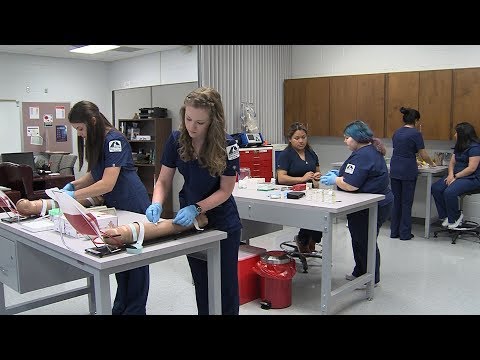Immunization Training for Medical Assistants
Contents
- Introduction to Immunizations
- The Importance of Immunizations
- The Types of Immunizations
- The Administration of Immunizations
- The Storage and Handling of Immunizations
- The Documentation of Immunizations
- The Billing of Immunizations
- The Reporting of Immunizations
- The Adverse Reactions to Immunizations
- The Immunization Schedules
Medical assistants are in a unique position to help increase immunization rates. They can do this by completing immunization training so they are better prepared to educate patients and staff about the importance of vaccines.
Checkout this video:
Introduction to Immunizations
Medical assistants play an important role in ensuring that patients receive the immunizations they need to protect themselves from preventable diseases. In this training, we will review the basics of immunizations, including how they work and how to administer them safely. We will also discuss some of the common questions that patients may have about immunizations. By the end of this training, you should feel confident in your ability to provide patients with accurate information about immunizations and to administer them correctly.
The Importance of Immunizations
Vaccines are among the most successful and cost-effective public health tools available for preventing disease and death. They not only protect vaccinated individuals, but also help protect entire communities by preventing and reducing the spread of infectious diseases.
Medical assistants play a vital role in ensuring that patients receive the immunizations they need according to the recommended schedules. By staying up to date on the latest recommendations and using best practices for vaccine administration, Medical Assistants can help make a real difference in the health of their patients and communities.
The Types of Immunizations
There are different types of immunizations that medical assistants may be asked to administer, and it is important to know the difference between them. The most common types of immunizations are listed below:
-Vaccines: Vaccines contain killed or weakened viruses, bacteria, or other organisms that cause disease. They work by prompting the body to produce immunity, or resistance, to a particular disease.
-Toxoids: Toxoids are vaccines made from toxins, or poisons, produced by bacteria. They work by prompting the body to produce immunity against the toxin, rather than the bacteria itself.
-Immune Globulin (IG): IG is a blood product that contains antibodies that can provide temporary immunity to certain diseases. It is used when someone has been exposed to a disease and cannot be vaccinated right away, or when there is a shortage of vaccine for a particular disease.
-Hospital Acquired Infections (HAI): HAIs are infections that occur in patients who are already in the hospital for other reasons. They can occur when bacteria from other patients or from hospital staff members contaminate the patient’s environment.
The Administration of Immunizations
The Administration of Immunizations by Medical Assistants
The role of the medical assistant in the administration of immunizations has been traditionally one of support to the physician. The medical assistant’s scope of practice has expanded in recent years, however, and many are now trained and certified to administer immunizations. This increase in responsibility is due in part to the fact that immunizations are one of the most effective ways to prevent disease, and medical assistants are in a unique position to provide this important service.
There are a few things to keep in mind when administering immunizations:
The type of vaccine: There are many different types of vaccines available, and each has its own set of instructions. It’s important to be familiar with the vaccine you are administering and follow the manufacturer’s instructions.
The patient’s age, weight, and health history: Certain vaccines are only recommended for certain age groups or for people with certain health conditions. It’s important to know this information before administering a vaccine.
The route of administration: Immunizations can be given intramuscularly (into the muscle), subcutaneously (under the skin), or intradermally (into the skin). The route will be determined by the type of vaccine being given.
The site of injection: The site of injection will also be determined by the type of vaccine. For most intramuscular injections, the deltoid muscle (upper arm) is used. For some vaccines, however, other sites may be used such as the gluteus muscle (buttocks) or lateral thigh. The site should be clean and free from scars or other lesions.
The Storage and Handling of Immunizations
One of the most important responsibilities of a medical assistant is the storage and handling of immunizations. Immunizations must be stored correctly in order to maintain their potency and to prevent deterioration or contamination.
There are several principles that must be followed when storing immunizations:
-Immunizations must be stored in a refrigerator or freezer. They should never be stored at room temperature.
-Immunizations should be stored in the original container. Do not store in generic containers.
-The expiration date on the vaccine vial should be checked before each use. Do not use vaccines that have expired.
-Immunizations should be protected from light. Store them in a dark place if possible.
-Do not freeze and then thaw immunizations unless directed to do so by the manufacturer.
When transporting immunizations, they should never be left unrefrigerated for more than 30 minutes. If they will be unrefrigerated for longer than 30 minutes, they should be placed in an insulated container with ice packs.
The Documentation of Immunizations
As a medical assistant it is important to know how to properly document immunizations in the patient’s chart. By law, all vaccine providers are required to report administered vaccines to the Immunization Information System (IIS). The IIS is a secure, web-based immunization registry that helps providers and parents or guardians keep track of a patient’s vaccinations.
When documentation of an immunization is entered into the patient’s chart, it is important to include the following:
-The date the vaccine was administered
-The type of vaccine
-The manufacturer of the vaccine
-The lot number of the vaccine
-The route of administration
-The site where the vaccine was injected
-The name, title, and signature of the person who administered the vaccine
The Billing of Immunizations
Medical assistants play a vital role in ensuring that patients receive the immunizations they need. In addition to administering the shots, medical assistants also play a key role in the billing process.
There are a few things to keep in mind when billing for immunizations:
– Make sure you are using the correct procedure code. The wrong code could result in the insurance company rejecting the claim.
– Be aware of any special immunization requirements that may be in place for your state or region. For example, some states require that certain vaccinations be given at specific intervals in order to be covered by insurance.
– Keep track of the patient’s immunization history. This will help you determine which shots the patient needs and when they need them.
Billing for immunizations can be tricky, but with a little bit of knowledge and attention to detail, it can be done correctly.
The Reporting of Immunizations
The Reporting of Immunizations Given by Medical Assistants
Medical assistants play an important role in ensuring that patient immunization records are up to date and complete. When immunizations are given, it is the medical assistant’s responsibility to ensure that the client’s record is updated with the correct vaccine, lot number, manufacturer, route, site, and dose. Additionally, The National Healthcare Association (NHA) requires that medical assistants report all adverse reactions to the vaccine manufacturer as well as the state or local department of health.
There are many ways that medical assistants can report adverse reactions to vaccines. The Advisory Committee on Immunization Practices (ACIP) has a Vaccine Adverse Event Reporting System (VAERS), which is a national vaccine safety surveillance program co-sponsored by CDC and FDA. Reports can be submitted online at www.vaers.hhs.gov, by fax at 1-877-721-0366, or by mail at:
Vaccine Adverse Event Reporting System
P.O. Box 1100
Rockville MD 20849-1100
The Adverse Reactions to Immunizations
Most people don’t have any adverse reactions to immunizations, but they can occur. It’s important to be able to recognize the signs and symptoms of an adverse reaction, so you can provide proper treatment.
The most common adverse reactions are mild and include pain and redness at the injection site, fever, headache, and muscle aches. These usually resolve within a few days. Serious reactions are rare, but can include allergic reactions, such as hives, difficulty breathing, and swelling of the face or throat. If you see any signs of a serious reaction, call 911 or your local emergency number immediately.
Other less common adverse reactions include:
-Nausea and vomiting
-Diarrhea
-Fatigue
-Joint pain or stiffness
The Immunization Schedules
There are two immunization schedules in the United States one for children aged 0 through 6 years old, and one for people aged 7 and older. Immunizations are given according to a schedule so that people will be protected from infectious diseases when they are most vulnerable.
The vaccines on the child and adolescent schedule are routinely given at the following ages:
-2 months
4 months
6 months
12 months
15-18 months
4-6 years
The vaccines on the adult schedule are routinely given at the following ages or intervals:
-19-21 years old (if not previously vaccinated)
-50 years old or older (if not previously vaccinated) Every 5 years thereafter







